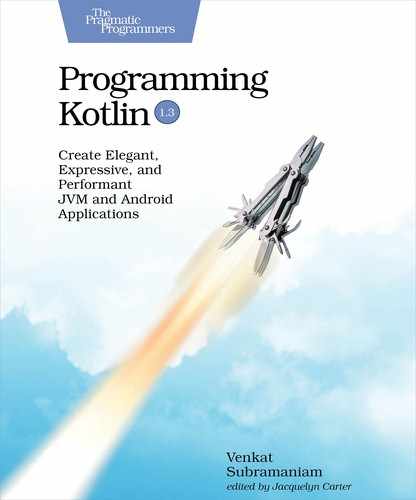Defining Domain Objects
Our app will make requests to the FAA web service to fetch the airport data. For this, we’ll need a variation of the Airport class we created in Chapter 18, Unit Testing with Kotlin. In Android Studio, in the Project pane, right click the package name com.agiledeveloper.airports under app/java and select New, and Kotlin File/Class. Change the value for Kind to Class and key in the name “Airport” in the text box next to the Name label.
Edit the generated file to create the Airport class, like so:
| | package com.agiledeveloper.airports |
| | |
| | import com.beust.klaxon.* |
| | |
| | class Weather(@Json(name = "Temp") val temperature: Array<String>) |
| | |
| | data class Airport( |
| | @Json(name = "IATA") val code: String, |
| | @Json(name = "Name") val name: String, |
| | @Json(name = "Delay") val delay: Boolean, |
| | @Json(name = "Weather") val weather: Weather = Weather(arrayOf(""))) { |
| | |
| | companion object { |
| | fun sort(airports: List<Airport>) : List<Airport> { |
| | return airports.sortedBy { airport -> airport.name } |
| | } |
| | |
| | fun getAirportData(code: String) = |
| | try { |
| | Klaxon().parse<Airport>(fetchData(code)) as Airport |
| | } catch(ex: Exception) { |
| | Airport(code, "Invalid Airport", false) |
| | } |
| | |
| | private fun fetchData(code: String) = |
| | java.net.URL("https://soa.smext.faa.gov/asws/api/airport/status/$code") |
| | .readText() |
| | } |
| | } |
The Weather class is used to store the temperature at an airport. An instance of this class is used within the Airport class, which comes next. The Airport class isn’t much different from the one we created in previous chapters. The getAirportData() function uses the Klaxon parser to create an Airport instance from the data received from the FAA web service. If there’s an error, it returns an Airport instance with the name Invalid Airport.
Let’s now create the AirportStatus file that will contain the function to make asynchronous calls to the Airport’s getAirportData() function. Create a file named AirportStatus.kt, following the steps that we used to create the Airport class. Change the contents of the generated file, like so:
| | package com.agiledeveloper.airports |
| | |
| | import kotlinx.coroutines.* |
| | |
| | suspend fun getAirportStatus(airportCodes: List<String>): List<Airport> = |
| | withContext(Dispatchers.IO) { |
| | val airports = airportCodes |
| | .map { code -> async { Airport.getAirportData(code) } } |
| | .map { response -> response.await() } |
| | |
| | Airport.sort(airports) |
| | } |
The getAirportStatus() function is the same as the one we implemented in the previous chapters. It makes the calls to getAirportData() asynchronously, from a thread within the Dispatchers.IO thread pool, instead of from the Main thread. Thus the UI thread won’t block when the code makes network calls. Since we already added the dependency to the kotlinx.coroutines library, we should have no trouble compiling this code.
We’re done with coding the part that gets data from the web service. Next, we’ll turn our attention to the UI.
